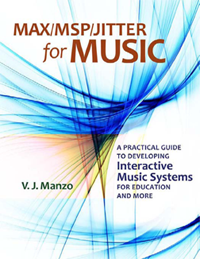Title: Max/Msp/Jitter for Music
Author: Vincent J. Manzo
Publisher: Oxford University Press
Year: 2011
Pages: 334
Another book about Max/Msp, but with a new interesting approach to one of the most famous computer music software.
Max/Msp is one of the most used computer music software, in particular by those involved in various ways with technology for musical purposes, and not only. In fact, this book dealing with Jitter, an environment for video developing and graphic creation in real time. We can mention many books involved with the software sold by Cycling ’74, probably each based on a particular topic. The same is for the book of Vincent J. Manzo, centered on music education.
The most interesting feature of this book is, probably, his particular point of view. In fact it is not a book thought for those interested to Max as a computer instrument for musical composition. Of course, they are important but not the most important. This book is for those interested in developing software or musical applications useful in the classroom to support the music education. In other way, this book reminds us how the technology revolutionized not only the music from a musician perspective but even the way in which we can set up a pedagogical path for music education, for those with or without musical skills.
Also the subtitle underlines this particularity: A practical guide to developing interactive music systems for education and more. I don’t know if this is a new approach to Max/Msp, but I’m sure it is different.
A practical guide to developing interactive music systems for education and more
Vincent J. Manzo seems to be a person of experience: composer, musician (he is a guitarist) and researcher interested to AI problems and music topics concerning with theory and composition. Probably, his technological interests, together with his teaching activity for the course of Music Technology at Polytechnic Institute in Worcester, Massachusetts, push him to write this book.
The educational element, very important, as we said, emerges already by the book structure. The author underlines that his book is very useful as reference manual for a semiannual course, taking care to dedicate at least two weeks for every chapter, excluding the sixth and twelfth, which, according to Manzo, require more time.
I think this last is an interesting focus point: the book offers to his readers not only arguments but also the structure for a hypothetic course dedicated to Max/Msp.
Each chapter dealing with a single topic, closed in himself: the book ranges from preliminary issues to topics about mathematics and music, from harmony studies to interactive systems useful to train musical hearing, from the realization of software for music analysis to applications for displaying chords studied in classroom.
In short, this book covers many topics, based on a hypothetical way that guides the reader towards a path of increasing difficulty, from the realization of simply applications to software more complex, but even more interesting.
Even this book was structured for a classroom teaching, his graphic design make him suitable even for a personal reading; without the teacher support. For this, I think that this book is useful even for those interested to learn the use of Max/Msp, probably to integrate it in own educational offer.
Proceeding with reading, we can design musical applications increasingly complex, useful to understand new opcodes, summarized at the end of each chapter. Patches are drawn very clearly, moreover the Author writes that all patches are tested and without errors. Is it true?
But what is the Max version to which this book refers? Manzo says that it is the sixth, but also the fifth. Actually, many indications in the book reports differences between the two versions.
The book by Vincent Manzo has also a multimedia attachment on the Oxford University Press web site. So, with user and password available in the book, entering on www.oup.com, it is possible to download source codes and others multimedia materials.
Personally, I think that this book is very interesting because helps his readers how to use the computer technology for music education. Above I think that cannot be denied that computer technology today have an important role to improve the educational offer. Also because the computer technology is a tool so close to the new generations. This book can become a valuable support for those teachers interested to renew their educational offer through a powerful software tool who knows even a large community of reference. The main problem of Max/Msp is its cost, which penalizes it if compared to other tools, powerful but free as Pure Data o Csound.

